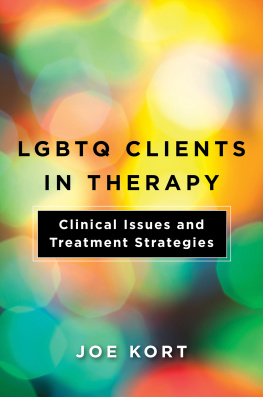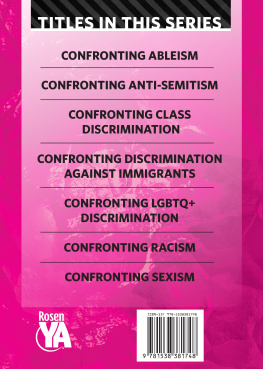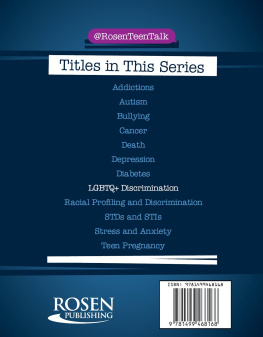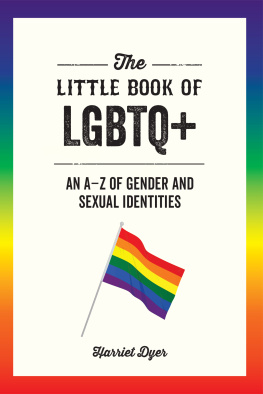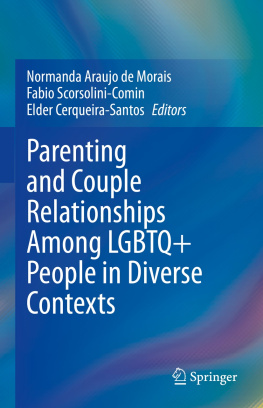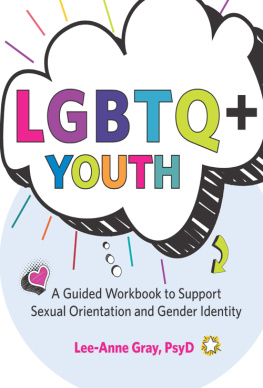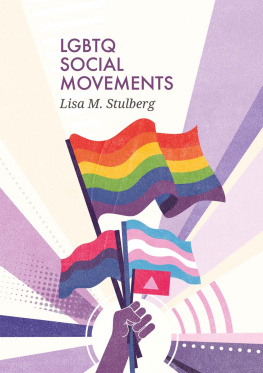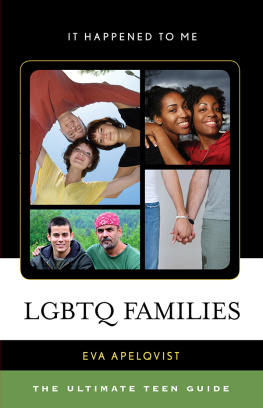
LGBTQ Clients
in Therapy
Clinical Issues and Treatment Strategies
Joe Kort

W. W. Norton & Company
Independent Publishers Since 1923
New York London
A NORTON PROFESSIONAL BOOK
Q: How many therapists does
it take to change a light bulb?
A: Only one. But the light bulb
has to want to change!
H istorically, LGBTQ people were told that their only salvation was to seek good psychotherapy and that they really had to want to change. If they werent highly motivated, they were told, psychotherapy would fail, condemning them to a life plagued by depression that would ultimately end in suicide.
Modern attitudes toward homosexuality, including those in psychotherapy, have religious, legal, and medical underpinnings, and prejudice and misinformation have prevailed over accurate information (Ritter & Terndrup, 2002). The past offers a sad litany of ineffective, wrongheaded treatments for homosexuality, right up to the present-day reparative therapy and sexual reorientation camps. Every such cure is based on some faulty etiology, yet the debate of nature versus nurture still rages with regard to the origins of homosexuality.
I will generally use homosexuality as an umbrella term to include all LGBTQ people. I will often use gay as an umbrella term to include all LGBTQ people. The context will be clear when I intend the more restricted meanings of these words. In particular, gay affirmative always means LGBTQ affirmative. Homophobia is used to mean LGBTQ-phobia.
Given this history of pathologizing homosexuality, LGBTQ clients are often understandably wary of psychotherapy and fear hiring a therapist who wont be objective about their gayness. Many seek out LGBTQ therapists, but this isnt necessarily the best step. Its no guarantee that they wont still receive doses of homophobia and heterosexism, as LGBTQ therapists can harbor negative thoughts about gay culture in general, even when they are comfortable with being LGBTQ themselves. It is therefore crucial that clinicians know and understand the history of psychotherapy for LGBTQ people. It is also important to remember that, like other clients, most LGBTQ clients seek therapy for help in dealing with their presenting problemsthey dont want to be bothered with what you might do or feel about their sexual orientation.
Even young LGBTQ clients who have not been directly exposed to the harmful effects of psychotherapeutic treatment for homosexuality are still well aware of the historical record. Furthermore, because of societal homophobia, straight therapists may receive negative transference just for being straight. It was, after all, heterosexist straight therapists who pathologized homosexuality as an alternative negative lifestyle.
Although the psychotherapy field has changed dramatically in its attitudes toward homosexuality over the past 60 years, homophobic therapists are still around, often treating patients while keeping their homophobia closeted and hiddenfrom their clients and even from themselves. Many of these therapists are involved in reparative therapyalso known as sexual reorientation therapy or conversion therapy. While today reparative therapy is judged by most mental health organizations as unethical, and some states are making it illegal, some therapists are still using it to help people change from gay to straight. Many of these therapists are religious and call it something other than reparative therapy. This chapter is geared toward helping clinicians treat clients who have directly experienced homophobia from psychotherapists who still use outdated modes of psychotherapy. The more you know and can show you know about LGBTQ history and gay affirmative therapy (GAT), as well as gay affirmative living, the more you will gain the trust of your LGBTQ clients and be able to help them effectively.
Nature or Nurture?
To date, there is no scientific evidence suggesting that homosexuality is either innate or learned. However, science seems to be on the side of biology, where it is probable that hormones and genes play a large role.
Research has indicated that sexual orientation may be related to maternal stress during pregnancy, to high or low prenatal sex hormone levels (either estrogen or testosterone), to an extra gene, to a smaller or larger hypothalamus, and even to different sizes of various sections of the brain (Wilson & Rahman, 2005). There is also growing evidence that the more male children a woman has, the higher the likelihood she will have a gay son. This is attributed to hormones. The best books on this topic are Born Gay: The Psychobiology of Sex Orientation (Wilson & Rahman, 2005) and Gay,Straight, and In-Between (Money, 1988). Clearly, more research is needed if we are to fully understand the impact of biology on sexual orientation.
Traditionally, psychology viewed homosexuality as a stage toward the natural, eventual goal of heterosexuality. There is still a belief among psychologists, social workers, and counselors that homosexuality is just straight gone bad, and that it is a behavior rather than a true orientation. The belief is that LGBTQ individuals didnt make it out of childhood or adolescence successfully. They are developmentally stalled and somehow damaged, like a moth whose wings did not open fully when it emerged from its cocoon. This theory leads many psychotherapists to believe that in adolescence, young men and women get a second chance to repair their homosexuality. But trying to repair something that is not broken does an untold amount of damage to these young peoples lives.
During ones teen years, experimenting with homosexual (and heterosexual) behavior is commonplace. Boys may engage in circle jerks or perform fellatio on one another, and girls may digitally masturbate each other or kiss to teach each other how to kiss boys. LGBTQ teens experiment both homosexually and heterosexually as well. This is where some of the controversy lies.
The heterosexist perspective viewed homosexual behavior as simply experimentation, because heterosexuality was seen as the natural ending for everyone. Thus, LGBTQ people were viewed as being developmentally stunted at the experimental stage and were accused of being confused, misguided heterosexuals acting out homosexually. Gay affirmative therapy, on the other hand, views homosexuality as the natural culmination of a sexual identitya sexual and romantic developmentnot as experimentation only.
Psychologists also used to believe that overprotective mothers and absent, distant fathers made their sons gay. Sadly, too many parents still believe this and come into therapy thinking they made their child LGBTQ. But these parental attitudes are a reaction rather than a cause. If a mother senses that her infant is different, she might react by being more protective of him, whereas a father may distance himself from his gay son. A similar impulse to blame the parents occurred with early hypotheses about the causes of schizophrenia. Mothers of schizophrenic adolescents and young adults typically showed little or no signs of attachment, leading psychologists to assume that these refrigerator moms were the root of the problem. Subsequent neurobiological research, of course, vindicated these mothers, who were simply reacting to their childrens inability to bond with them.
Now that we are more than certain that family constellations do not make a child LGBTQ, we must begin the task of cleaning up the mess that therapy has left. The psychotherapy ghosts of the past still haunt the therapy sessions of today, and clients can be equally vulnerable to archaic thinking and outdated myths that may keep them closeted.
Next page
